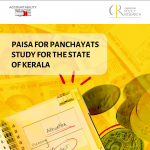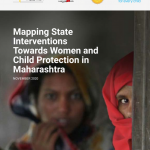
Studying the State in a Digital Epoch
7 October 2019
Since the launch of the Digital India campaign in 2015, the role of Information Technology (IT) within the government has grown from a tool to improve the efficiency and accuracy of existing processes to an all-encompassing programme. It envisions not just the transformation of public services but also the creation of a ‘digitally empowered society’. With regard to e-governance in particular, the Digital India campaign’s ultimate objective is to improve governance overall by adhering to the mantra of ‘less government, more governance’. In this blog, I explore what ‘less government’ means for the use of IT in the government, and discuss the need to study its implementation.
The Digital India campaign brings together a variety of services under its umbrella, including government-to-citizen (G2C), government-to-business (G2B), government-to-government (G2G), government-to-employee (G2E), as well as systems that integrate and/or work across these categories (such as the UMANG application). While G2C e-governance initiatives like the Common Service Centres (CSCs) scheme and their impact on service delivery and citizen experience have been studied, G2G e-governance initiatives such as fund transfer systems and Management Information Systems (MIS) that track key inputs and outputs for various schemes remain understudied. As per one estimate, there are more than 400 government MIS portals just for Direct Benefit Transfers. And that is just the tip of the iceberg – almost every government programme is now linked to a unique MIS portal through which progress is recorded and tracked.
What do we know about these G2G systems? How do they impact governance? Do they improve service delivery? One can begin to formulate and answer these questions by examining the objective under which such G2G systems have been created. As per the Digital India webpage on e-governance, IT is critical for the simplification and transformation of government processes in order to make them more efficient and effective. This assumes a relationship between the use of IT to simplify and transform government processes, and their increased efficiency and effectiveness. With that in mind, we need to understand what this ‘transformation’ entails and what efficiency and effectiveness mean, in this context.
Unlike private sector organisations, the perception of ‘efficiency’ and ‘effectiveness’ within government is not tied to maximising profit but rather to delivering on the contract between the state and citizen and creating some public value. The expectation that e-governance initiatives will facilitate accurate, durable and impartial records is in-built. The Digital India campaign aims to deliver this through ‘less government’ – cutting down paperwork and virtually removing the human interface between the citizen and the state (see image below). Yet, despite these visions of automation and increased transparency, in practice, computers in government offices are often “nothing more than modern typewriters”. The cogs of the state machinery, especially at the district and sub-district levels, still rely on paperwork, files and note sheets to turn. So how is this reliance on paper affected as we move towards a ‘Digital India’? Are digital technologies helpless against the entrenched systems? Too many examples have already shown that G2G e-governance initiatives such as MIS portals are “not magic”. In an article in The Indian Express, Yamini Aiyar, Shrayana Bhattarcharya, and Lant Pritchett, suggest that systems that aim to do away with the human element may actually be counterproductive altogether. ‘Less government’ discounts the very functionaries who implement existing government processes and are critical to their success.

Source: e-Mitra, Digital India website, last accessed on 26 September 2019. Available here.
While working within a Zila Parishad office to monitor and support the implementation of the Swachh Bharat Mission – Gramin (SBM -G), I became familiar with SBM-G’s MIS portal. A critical element of the programme, the portal hosts all of the data and metrics used for implementation as well as monitoring by successive levels of administration. Observing the socio-political and organisational context under which the information on the MIS portal is collected, recorded, and disseminated revealed a diverse set of challenges. It underscored the dependence on and the relevance of functionaries associated with e-governance systems. Who enters household details in the SBM MIS? Who documents the toilets that are built and how? Who are the clerks who approve or verify the paperwork involved? Who enters the data into the digital system and how? How does the state itself engage with the data that it collects? The search for these answers emphasised that government data cannot be understood without seeing ‘behind-the-screen’, without examining the objectives that prompt the design of the MIS portal, and the processes of data collection itself.
Despite visions of automation and increased transparency, in practice, computers in government offices are often “nothing more than modern typewriters”.
An output-focused approach to studying MIS portals and their usage ignores the processes that are critical to achieving the goals of e-governance in their totality. Further, studying the state from the outside limits the understanding of how the state comes to be. Regardless of the impact of these everyday processes, recording these experiences and vignettes of life within the state can help untangle the peculiar-seeming practices that govern bureaucracies. If there is one thing I have learned while working within government offices it is that the state is far from static. Despite being “rule-bound”, bureaucratic processes are constantly evolving in ways that even those within the state may not immediately perceive. In his research on digital monitoring systems for MGNREGA in Andhra Pradesh, Rajesh Veeraraghavan finds that the “weapon” that the senior bureaucrats used as a system of control is subverted by field-level functionaries to further their own interests. For example, when Veeraraghavan looked into MGNREGA workers’ complaints about not being assigned work by the computer system, he found that there was no such systemic glitch. Rather, MGNREGA field assistants were using technology failure as a shield to hide their conflict with the workers that had prevented them from uploading their information in the first place.
There may even be multiple levels of such subversion at play within the same system. In my experience, a major opportunity for subversion is the continued entrenchment of paper-based records in the government system. The simultaneous use of paper-based and digital systems is often intentional but misunderstood as a lack of capacity, and can be exploited by functionaries to slip decisions through the cracks and disguise gaps in service delivery much like the MGNREGA example shared here. Research efforts that look into the usage of digital systems, including such subversions, can feed into the design process for subsequent iterations or new MIS platforms. Additionally, this can contribute toward the literature on the seemingly mundane practices that are integral to conceptualising how the Indian state builds its own legitimacy, authority and power in the age of the internet. By combining process evaluations with ethnographic research as a participant-observer, one can draw attention to the processes through which the state fails, is made opaque, or, in the best case, effective, against the backdrop of ‘Digital India’.
In a blog post reflecting on the implementation of e-governance, former senior bureaucrat T.R. Raghunandan observed: “The champions of e-Governance have already moved on, even before the systems they develop are entrenched in government processes.” We stand to learn from studying such phenomenon. Regardless of which direction the ‘entrenchment’ goes, the mere use of a digital system creates the image of a modern and technologically advanced state – the ‘Digital India’ we have been promised. But to what extent has it been achieved? I, for one, will be heading back into government offices to find out.





